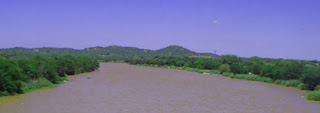Once again we left Doha on the red-eye special…haven’t figured out why all flights seem to leave at 2 in the morning…perhaps we’re just cheap and it’s the price…
 |
| AISJ and those wonderful clouds! |
We arrived in Johannesburg bright and early in the morning…and immediately noticed the wonderful white fluffy clouds. Now sometimes I must admit the beautiful clouds turned dark and dropped some heavy duty rain on us – nothing like our Portland rain - but these were just the wonderful fleeting images clouds and I never seemed to tire of them. They followed us everywhere on the trip, making the sky and sunsets just gorgeous.
 |
| African Hoopoe |
Suzanne took us out on a great tour of Jo’burg, heading out for the international school where she was teaching, through the maze of streets and sights, and finally to her home. She lives out in the suburbs where there’s less traffic and noise, parks to walk in while dodging the dogs and poo (no pooper scooper laws here) but also to just relax. It was delightful to wake up to the sight and sounds of birds flitting through her yard and the park. The African Hoopoe caught my attention with its bright red head and zebra striped wings. I worked on lots of pictures of birds on this trip…and caught few.
 |
| Indaba Restaurant with Suzanne |
We headed for a great African restaurant that night – a smorgasbord so that we could sample lots of different foods. Beautiful setting overlooking a pond, more birds, beautiful sunset…and lots of great food! Jeff found lots of new meats available…ostrich, kudu, ox, springbok…and maybe others we can’t remember. They also have a wonderful butternut squash dish – actually many different dishes. Some salads were similar while others included different tastes and spices – a real delight to enjoy so many new tastes.
 |
| African Sunset |
After dinner…and severe jet lag…we wisely (huh) took off downtown to see what Suzanne thought was a play. It turns out it was a story of the South African people told in song…but much of it not in English. The ambiance was great, the rhythm moving, the room warm and the eyes drooping. It was held in a small area of town where there was a lot of development going on, various shops to wander through and an old town feel. South Africa isn’t a place to wander about too far at night but fortunately Suzanne has explored various places areas with movie theaters, restaurants and such that are great for an evening out. On our own, and without her knowledge, we’d have probably been stuck staying closer to home. I did get a picture of the Nelson Mandela Bridge at night – it was near the theater area we went to.
The next day found us in the township of Soweto, at Nelson Mandela’s home. Suzanne took us around the streets, through the museum and out to eat at a small local restaurant.
We enjoyed a very typical African dish of pap (cooked maize, similar to cooked cornmeal) and spicy vegetables – delicious and extremely filling! One of the gentlemen there was drinking a local brew from the traditional bowl and shared some with Suzanne and Jeff.














































